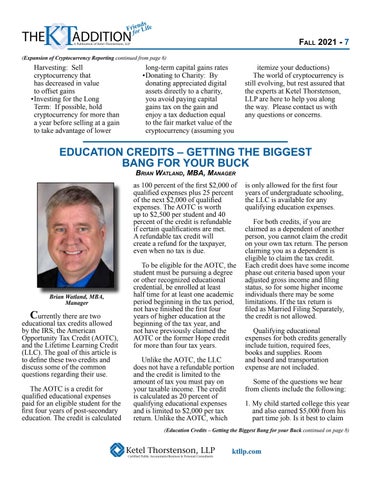Fall 2021 - 7 (Expansion of Cryptocurrency Reporting continued from page 6)
Harvesting: Sell cryptocurrency that has decreased in value to offset gains • Investing for the Long Term: If possible, hold cryptocurrency for more than a year before selling at a gain to take advantage of lower
long-term capital gains rates • Donating to Charity: By donating appreciated digital assets directly to a charity, you avoid paying capital gains tax on the gain and enjoy a tax deduction equal to the fair market value of the cryptocurrency (assuming you
itemize your deductions) The world of cryptocurrency is still evolving, but rest assured that the experts at Ketel Thorstenson, LLP are here to help you along the way. Please contact us with any questions or concerns.
EDUCATION CREDITS – GETTING THE BIGGEST BANG FOR YOUR BUCK Brian Watland, MBA, Manager
as 100 percent of the first $2,000 of qualified expenses plus 25 percent of the next $2,000 of qualified expenses. The AOTC is worth up to $2,500 per student and 40 percent of the credit is refundable if certain qualifications are met. A refundable tax credit will create a refund for the taxpayer, even when no tax is due.
Brian Watland, MBA, Manager
Currently there are two educational tax credits allowed by the IRS, the American Opportunity Tax Credit (AOTC), and the Lifetime Learning Credit (LLC). The goal of this article is to define these two credits and discuss some of the common questions regarding their use. The AOTC is a credit for qualified educational expenses paid for an eligible student for the first four years of post-secondary education. The credit is calculated
To be eligible for the AOTC, the student must be pursuing a degree or other recognized educational credential, be enrolled at least half time for at least one academic period beginning in the tax period, not have finished the first four years of higher education at the beginning of the tax year, and not have previously claimed the AOTC or the former Hope credit for more than four tax years. Unlike the AOTC, the LLC does not have a refundable portion and the credit is limited to the amount of tax you must pay on your taxable income. The credit is calculated as 20 percent of qualifying educational expenses and is limited to $2,000 per tax return. Unlike the AOTC, which
is only allowed for the first four years of undergraduate schooling, the LLC is available for any qualifying education expenses. For both credits, if you are claimed as a dependent of another person, you cannot claim the credit on your own tax return. The person claiming you as a dependent is eligible to claim the tax credit. Each credit does have some income phase out criteria based upon your adjusted gross income and filing status, so for some higher income individuals there may be some limitations. If the tax return is filed as Married Filing Separately, the credit is not allowed. Qualifying educational expenses for both credits generally include tuition, required fees, books and supplies. Room and board and transportation expense are not included. Some of the questions we hear from clients include the following: 1. My child started college this year and also earned $5,000 from his part time job. Is it best to claim
(Education Credits – Getting the Biggest Bang for your Buck continued on page 8)
ktllp.com







